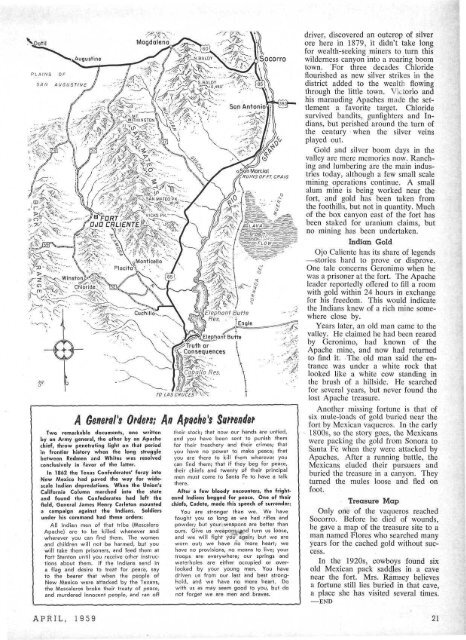april on the desert - Desert Magazine of the Southwest
april on the desert - Desert Magazine of the Southwest
april on the desert - Desert Magazine of the Southwest
Create successful ePaper yourself
Turn your PDF publications into a flip-book with our unique Google optimized e-Paper software.
y^ / .#^ or \/A :: ASocorro<br />
C C<strong>on</strong>sequences<br />
'j^Jjk; 'fj^4y£S30S^ii<br />
A Genetsl's Otdets; An Apache's Swendet<br />
Two remarkable documents, <strong>on</strong>e written<br />
by an Army general, <strong>the</strong> o<strong>the</strong>r by an Apache<br />
chief, throw penetrating light <strong>on</strong> that period<br />
in fr<strong>on</strong>tier history when <strong>the</strong> l<strong>on</strong>g struggle<br />
between Redmen and Whites was resolved<br />
c<strong>on</strong>clusively in favor <strong>of</strong> <strong>the</strong> latter.<br />
In 1862 <strong>the</strong> Texas C<strong>on</strong>federates' foray into<br />
New Mexico had paved <strong>the</strong> way for widescale<br />
Indian depredati<strong>on</strong>s. When <strong>the</strong> Uni<strong>on</strong>'s<br />
California Column marched into <strong>the</strong> state<br />
and found <strong>the</strong> C<strong>on</strong>federates had left <strong>the</strong><br />
field. General James Henry Carlet<strong>on</strong> mounted<br />
a campaign against <strong>the</strong> Indians. Soldiers<br />
under his command had <strong>the</strong>se orders:<br />
All Indian men <strong>of</strong> that tribe (Mescalero<br />
Apache) are to be killed whenever and<br />
wherever you can find <strong>the</strong>m. The women<br />
and children will not be harmed, but you<br />
will take <strong>the</strong>m pris<strong>on</strong>ers, and feed <strong>the</strong>m at<br />
Fort Stant<strong>on</strong> until you receive o<strong>the</strong>r instructi<strong>on</strong>s<br />
about <strong>the</strong>m. ]f <strong>the</strong> Indians send in<br />
a flag and desire to treat for peace, say<br />
to <strong>the</strong> bearer that when <strong>the</strong> people <strong>of</strong><br />
New Mexico were attacked by <strong>the</strong> Texans,<br />
<strong>the</strong> Mescaleros broke <strong>the</strong>ir treaty <strong>of</strong> peace,<br />
and murdered innocent people, and ran <strong>of</strong>f<br />
APRIL, 1959<br />
<strong>the</strong>ir stock; that now our hands are untied,<br />
and you have been sent to punish <strong>the</strong>m<br />
for <strong>the</strong>ir treachery and <strong>the</strong>ir crimes; that<br />
you have no power to make peace; that<br />
you are <strong>the</strong>re to kill <strong>the</strong>m wherever you<br />
can find <strong>the</strong>m; that if <strong>the</strong>y beg for peace,<br />
<strong>the</strong>ir chiefs and twenty <strong>of</strong> <strong>the</strong>ir principal<br />
men must come to Santa Fe to have a talk<br />
<strong>the</strong>re.<br />
After a few bloody encounters, <strong>the</strong> frightened<br />
Indians begged for peace. One <strong>of</strong> <strong>the</strong>ir<br />
chiefs, Cadete, made this speech <strong>of</strong> surrender:<br />
You are str<strong>on</strong>ger than we. We have<br />
fought you so l<strong>on</strong>g as we had rifles and<br />
powder; but your>*weap<strong>on</strong>s are better than<br />
ours. Give us weap<strong>on</strong>s^^jid turn us loosie,<br />
and we will fight yd'u'again; but we are<br />
worn out; we have no more heart; we<br />
have no provisi<strong>on</strong>s, no means to live; your<br />
troopis are everywhere; our springs and<br />
waterholes are ei<strong>the</strong>r occupied or overlooked<br />
by your young men. You have<br />
driven us from our last and best str<strong>on</strong>ghold,<br />
and we have no more heart. Do<br />
with us as may seem good to you, but do<br />
not forget we are men and braves.<br />
driver, discovered an outcrop <strong>of</strong> silver<br />
ore here in 1879, it didn't take l<strong>on</strong>g<br />
for wealth-seeking miners to turn this<br />
wilderness cany<strong>on</strong> into a roaring boom<br />
town. For three decades Chloride<br />
flourished as new silver strikes in <strong>the</strong><br />
district added to <strong>the</strong> wealth flowing<br />
through <strong>the</strong> little town. Vktorio and<br />
his marauding Apaches made <strong>the</strong> settlement<br />
a favorite target. Chloride<br />
survived bandits, gunfighters and Indians,<br />
but perished around <strong>the</strong> turn <strong>of</strong><br />
<strong>the</strong> century when <strong>the</strong> silver veins<br />
played out.<br />
Gold and silver boom days in <strong>the</strong><br />
valley are mere memories now. Ranching<br />
and lumbering are <strong>the</strong> main industries<br />
today, although a few small scale<br />
mining operati<strong>on</strong>s c<strong>on</strong>tinue. A small<br />
alum mine is being worked near <strong>the</strong><br />
fort, and gold has been taken from<br />
<strong>the</strong> foothills, but not in quantity. Much<br />
<strong>of</strong> <strong>the</strong> box cany<strong>on</strong> east <strong>of</strong> <strong>the</strong> fort has<br />
been staked for uranium claims, but<br />
no mining has been undertaken.<br />
Indian Gold<br />
Ojo Caliente has its share <strong>of</strong> legends<br />
—stories hard to prove or disprove.<br />
One tale c<strong>on</strong>cerns Ger<strong>on</strong>imo when he<br />
was a pris<strong>on</strong>er at <strong>the</strong> fort. The Apache<br />
leader reportedly <strong>of</strong>fered to fill a room<br />
with gold within 24 hours in exchange<br />
for his freedom. This would indicate<br />
<strong>the</strong> Indians knew <strong>of</strong> a rich mine somewhere<br />
close by.<br />
Years later, an old man came to <strong>the</strong><br />
valley. He claimed he had been reared<br />
by Ger<strong>on</strong>imo, had known <strong>of</strong> <strong>the</strong><br />
Apache mine, and now had returned<br />
to find it. The old man said <strong>the</strong> entrance<br />
was under a white rock that<br />
looked like a white cow standing in<br />
<strong>the</strong> brush <strong>of</strong> a hillside. He searched<br />
for several years, but never found <strong>the</strong><br />
lost Apache treasure.<br />
Ano<strong>the</strong>r missing fortune is that <strong>of</strong><br />
six mule-loads <strong>of</strong> gold buried near <strong>the</strong><br />
fort by Mexican vaqueros. In <strong>the</strong> early<br />
1800s, so <strong>the</strong> story goes, <strong>the</strong> Mexicans<br />
were packing <strong>the</strong> gold from S<strong>on</strong>ora to<br />
Santa Fe when <strong>the</strong>y were attacked by<br />
Apaches. After a running battle, <strong>the</strong><br />
Mexicans eluded <strong>the</strong>ir pursuers and<br />
buried <strong>the</strong> treasure in a cany<strong>on</strong>. They<br />
turned <strong>the</strong> mules loose and fled <strong>on</strong><br />
foot.<br />
Treasure Map<br />
Only <strong>on</strong>e <strong>of</strong> <strong>the</strong> vaqueros reached<br />
Socorro. Before he died <strong>of</strong> wounds,<br />
he gave a map <strong>of</strong> <strong>the</strong> treasure site to a<br />
man named Flores who searched many<br />
years for <strong>the</strong> cached gold without success.<br />
In <strong>the</strong> 1920s, cowboys found six<br />
old Mexican pack saddles in a cave<br />
near <strong>the</strong> fort. Mrs. Ramsey believes<br />
a fortune still lies buried in that cave,<br />
a place she has visited several times.<br />
—END<br />
21

















